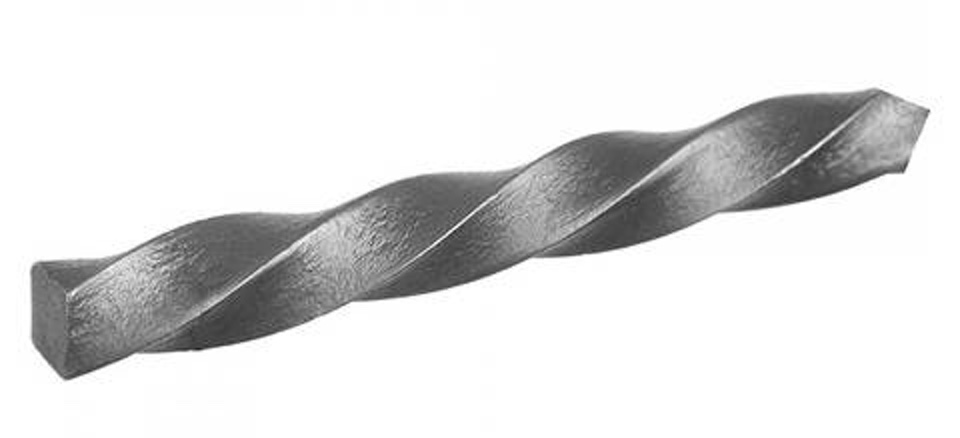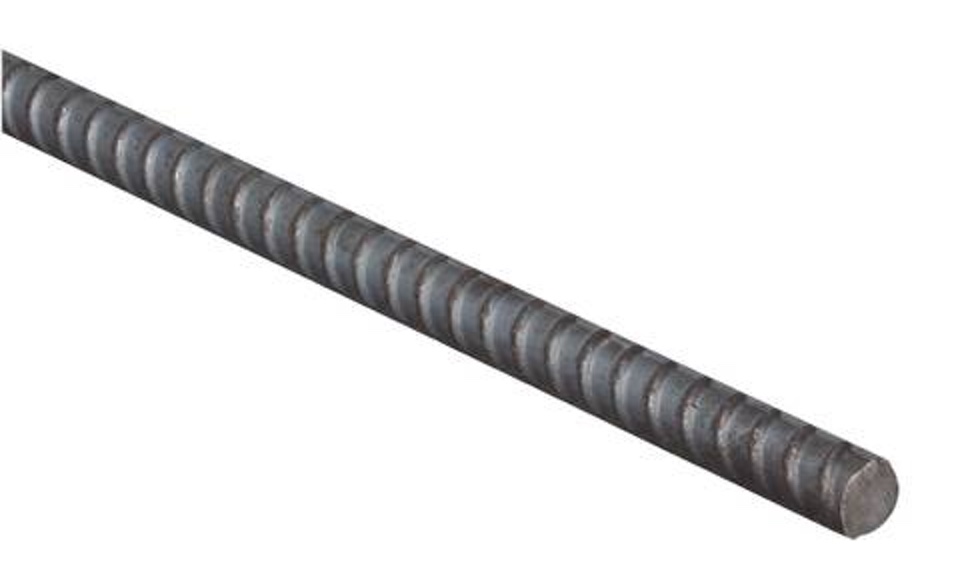Rebar and reinforced concrete
October 19, 2024 at 2:34 PM by Dr. Drang
A recent episode of the 99% Invisible podcast, “Brilliantly Boring,” covers a topic near and dear to my heart: reinforced concrete—more specifically, the rebar that does the reinforcing. The show does an excellent job in a short period. I just want to fill in some details.
The show is structured around the Alvord Lake Bridge in Golden Gate Park. Built in 1889, it’s one of the earliest reinforced concrete structures that’s still around. It was designed by Ernest Ransome, the guy who made rebar (almost) what it is today.
Iron and steel bars were used to reinforce concrete before Ransome. Joseph Monier of France is usually credited with starting the systematic study and use of reinforced concrete back in the 1850s. But as far as I know, the reinforcing bars and wires that Monier used were smooth, round bars with no texture or bumpiness. Ransome used bars that were made of square stock that had been twisted, like this:

Image from Walcoom Corporation.
The twist helps prevent the bar from slipping relative to the concrete. This makes them act together, which is how reinforced concrete gets its strength. In the show, they say that the twist “gives it an adhesive quality to the concrete itself,” which isn’t quite right. What the twist does is provide what’s called mechanical interlock. For a twisted bar to slip, it has to both break the adhesive bond with the surrounding concrete and push it out of the way so it can slide past. This extra resistance to slip is what made twisted bars work better.
Nowadays, we almost always use what are called deformed bars, which have little ribs on the surface to provide the interlock.

Image from Walcoom Corporation.
But twisted rebar had a strong run in the early days of reinforced concrete. Many years ago, a friend and coworker of mine was directing some repair work at the Unity Temple in Oak Park, Illinois. This is a Unitarian Universalist church designed by Frank Lloyd Wright at the beginning of the 20th century. One day my friend called me into his office. “You have to see this,” he said, as he handed me a three-foot length of twisted rebar. “This is original Frank Lloyd Wright rebar. I found it in the trash. They were going to throw it away!” So I got to hold a piece of architectural and structural engineering history because of my friend’s dumpster diving.
Why do we need to use rebar? As they say in the podcast, concrete is strong in compression but relatively weak in tension. The usual rule of thumb is that its tensile strength is about one-tenth its compressive strength. This pretty much limits unreinforced concrete to structures that never undergo tensile stresses. But if we put rebar into concrete where tension will develop, that tension will be carried by the steel, and we can use concrete in almost any kind of structure.1
There is a problem, though. The highest tensile stresses tend to occur at the outer edges of structures, right along the surface. So to get the most benefit from rebar, we want to put it as close to the surface as possible. Unfortunately, concrete is porous, and water can work its way in, come in contact with the steel, and cause it to corrode. This has two effects:
- It reduces the amount of competent steel, weakening the structure.
- The iron oxide corrosion products take up more volume than the original steel. The expansion of the corroding rebar creates an outward pressure on the surrounding concrete, leading to cracking and spalling. This further exposes the rebar, leading to more corrosion in a vicious circle.
To protect the rebar from water infiltration, there are design rules about how far from the surface the rebar must be placed (this is called concrete cover). But as we said earlier, placing the rebar away from the surface makes it less effective in resisting tensile stresses. As in all types of design, there are trade-offs, and here the trade-off is between strength and longevity.
As you may know, salt water is more corrosive than fresh water because of the chloride ions from the dissolve NaCl. So reinforced concrete in coastal environments and northern climates, where salt is used on roadways, is especially susceptible to deterioration from rebar corrosion. If you look up while driving under any number of old reinforced concrete bridges in Chicago, you’ll see plenty of rusted and exposed rebar.
If you want to see Ransome’s work, and are leery of going to the Alvord Lake Bridge (the podcast says it’s in a sketchy section of the park), you can go to the Cantor Center for Visual Arts on the Stanford campus. The original building was built in 1891, just a couple of years after the bridge, and is made of reinforced concrete as designed by Ransome. The building was expanded in the early 1900s, using masonry construction, which was a bad idea. The new wings collapsed during the 1906 earthquake, leaving only Ransome’s work still standing. His part of the building also survived the Loma Prieta earthquake of 1989, the 35th anniversary of which was just a couple of days ago.
By the way, although Stanford’s page about the building says it used “a new method of cast-in-place concrete reinforced with twisted metal rods,” just like the Alvord Lake Bridge, James MacGregor’s well-regarded textbook, Reinforced Concrete: Mechanics & Design, says that while Ransome used twisted bars in other structures, he “used discarded cable car rope as beam reinforcement” in the museum. I don’t know which is correct, but the helically wound wires in cable car ropes would also provide good mechanical interlock.
It took me a while to write this post, mainly because I kept veering off on tangents about Frank Lloyd Wright’s home and office in Oak Park, strain compatibility, the weird belief among some people that Roman concrete was better than today’s, compression-only structures, rebar size nomenclature, and the tendency for concrete to use the waste products of other industries (like flyash and, perhaps, discarded cable car rope). I hope you appreciate how I managed to edit it down.
-
Yes, I know that rebar is also used to resist compression and shear. I’m trying to keep things simple. ↩
